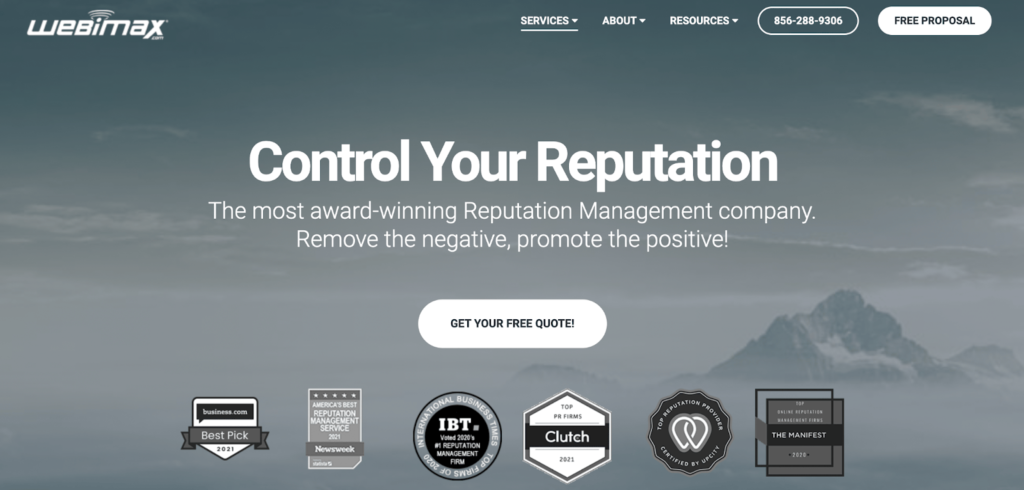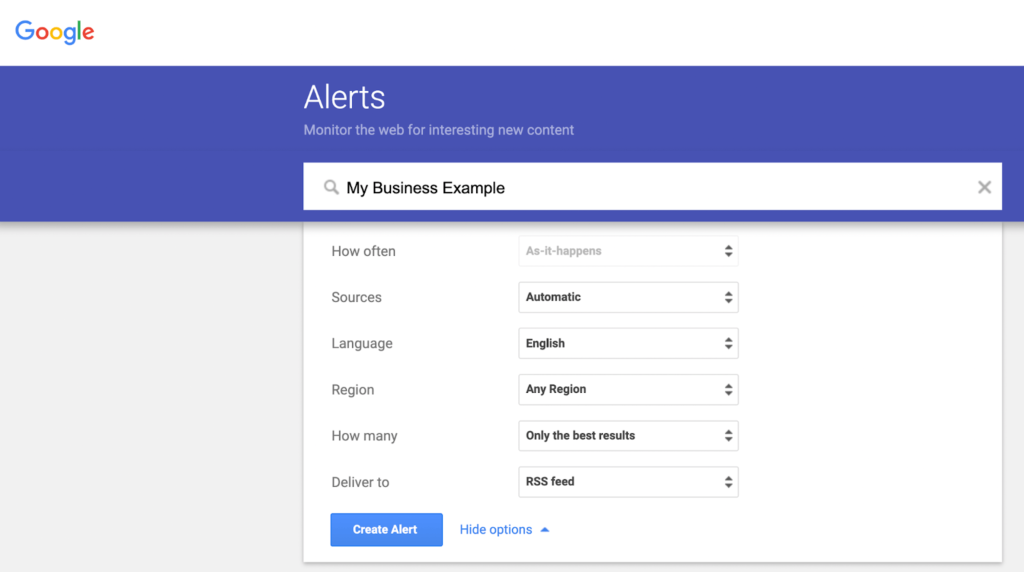Did you know that 65% of people trust online search engines the most when researching a business?
Clearly, online reputation can make or break your business. While positive reviews can bring you more business, anything negative can drastically damage your brand‘s credibility. That’s why you should know how to effectively control bad PR.
Keep reading to learn the best strategies for repairing your company’s online reputation.
Top-Rated Online Reputation Management Companies to Repair Your Company’s Reputation
Our top recommendation for most people who need help with online reputation management is WebiMax because of their deep experience and affordable pricing. Get in touch with WebiMax today for a free quote.
Unless you really know what you are doing, a professional service will resolve issues with your online reputation is much faster. Here are the best ones we’ve found:
- WebiMax — Best overall
- NetReputation – Best for ultra-responsive customer support
- InternetReputation.com – Best for personal reputation management
- Reputation Defense Network — Best for permanently removing false content
- Podium — Best for getting reviews automatically
- SEO Image — Best for legal and medical practices
- Gadook — Best for rebranding after reputation attacks
- BirdEye — Best for getting Google and Facebook reviews
- Reputation.com — Best for knowing your competition’s reputation
- Go Fish Digital — Best for improving Yelp reviews
- Netmark.com — Best for hands-off, fast responses to reputation hits
You can read the full reviews of each online reputation management company here.
What is Online Reputation Management Repair?
Reputation management is the process of improving your company’s perception in online reviews, social media posts, search engine results, news outlets, and other online sources.
Businesses with a negative reputation can apply different strategies to build and repair their brand image. This may include content removal, negative review deletion, claiming business profiles, responding to customer reviews, and other tactics to enhance your company’s online perception.
Understand that the steps you take to repair your online reputation may not pay immediate dividends. If you are expecting to be able to repair your brand image in a couple of hours, you are going to experience disappointment.
The repair of your brand reputation is going to take a period of time. The steps you implement today are going to need to be part of an overall brand management strategy. You may need to rebuild your website to make it more useful for visitors, and you may need to solicit multiple positive reviews from customers to negate the negative reviews.
You also should be implementing the strategy for improving your online reputation at the same time you are working to improve your overall customer service reputation. Better customer service and responsiveness should lead to more positive customer reviews, which, in turn, helps your online reputation.
The Basics of Repairing Your Company’s Online Reputation
There are a wide range of factors that can impact the online reputation of a business. But when it comes to reputation repair, the following key factors will play the largest role in this process.
Identifying the Source
What specifically damaged your company’s reputation in the first place? You can’t effectively fix something if you don’t know the root cause.
There are literally hundreds, if not thousands, of unique scenarios that could hurt a business and its online perception. Examples include:
- Faulty or unsafe product
- Offensive marketing campaign
- Insensitive public comments made by owner or CEO
- Poor customer service
- Data breach that leaked sensitive customer information
- Bad press instigated by a competitor or other external source
One review about a single employee or broken product is not typically the source of a bad reputation. Typically, the source is something that had a more significant impact on a larger group of people.
Customer Reviews
Most consumers read online reviews before buying anything. These reviews are generally a reliable indication of how your company is perceived online.
Not every customer is going to be happy. So a handful of bad reviews are always expected. But if your company has more negative reviews than positive ones, it’s likely signs of a bigger problem.
Understanding your customer reviews can be really helpful in identifying the source of your damaged reputation. Figuring out ways to eliminate bad reviews and get more positive reviews will ultimately play a significant role in repairing your damaged reputation.
Once you implement some solutions for solving customer problems and for improving your customer service, you may want to reach out to those who left poor reviews and ask them for another chance. Some of these people may revise their original review when they can see that you are trying to improve your processes.
Building Trust
Consumers won’t buy products or services from a company that they can’t trust. This statement holds true for B2B buyers as well.
As you’re going through the reputation repair process, you’ll need to come up with quick wins for showing your company is trustworthy. Examples might include:
- Using HTTPS to secure your website
- Adding trust seals to your site during the checkout process
- Providing excellent customer service
- Clearly displaying your company address, phone number, and other contact information online
- Asking for feedback
- Showcasing reviews and customer testimonials
- Eliminating ads or pop-ups from your site
Some businesses lose the trust of their customers through a lack of transparency. Things like not publishing your return policy online or setting up recurring billing without customer consent would fall into this category. If you find you’re not being fully transparent with your customers, that’s a great place to start your reputation repair.
Either way, make sure that all of your initiatives moving forward are focused on your trustworthiness.
Establishing Credibility
Online credibility helps prove your company’s legitimacy. It shows that you’re a reputable brand that keeps its promises.
One excellent way to establish credibility during reputation repair is by partnering with an influencer who already has credibility. Let’s say you have a weight loss supplement company. Having someone like Oprah stand behind your brand and attest to the product’s benefits would provide instant credibility.
Obviously, not every business has access to globally recognized celebrities or the budget to attain them. But there are other ways to establish credibility using this same concept, like:
- Having a doctor provide a stamp of approval for your product’s safety
- Getting featured in a blog post published by an authoritative source in your industry
- Creating case studies and success stories to highlight on your website
Ensuring that current and prospective customers know that your products or services do what they’re intended to do is an important factor in reputation repair.
Controlling Your Online Presence
Your website alone isn’t enough to repair your company’s reputation. You must take other steps to build, maintain, and establish a positive reputation online.
This includes having an active presence on all relevant social media platforms, claiming business profiles on review sites, putting out press releases, and feeding positive stories to media sources.
These types of strategies give you much more control over your reputation because you’ll have more platforms to speak from.
Even small details like a notice on your Yelp profile saying that the business is unclaimed can create a negative perception of your business in the eyes of anyone viewing the page.
Establishing a positive presence on multiple platforms also gives you the chance to produce relevant content that can drown out negative stories on the web. So when someone Googles your business, the content you’re putting out can be shown above other results with a negative sentiment.
3 Tools to Repair Your Company’s Online Reputation
These three solutions will simplify your reputation repair strategies and help you improve your reputation faster.
#1 — WebiMax

WebiMax is one of the most trustworthy and reliable reputation management companies on the market today. They provide an extensive list of services and tools that can help repair even the most damaged business reputations.
Start with an audit, and WebiMax will provide you with a realistic timeline and a customized strategy to proceed with.
They handle negative review removal, negative content deletion, positive content promotion, and online PR services, and can even help you leverage all your unclaimed business profiles. WebiMax offers useful tools including a review collection dashboard, a local listings management tool, and a social monitoring dashboard.
#2 — Google Alerts

Google Alerts is an excellent free tool that helps you monitor what’s being said about your company online. You can use it to create custom alerts from online sources like news sites, blogs, web results, videos, books, discussions, and more. Set up alerts by location, language, and how often you want to receive notices.
This gives you the opportunity to act quickly if a story is published about your business online. If the story is positive, you can promote it to improve your reputation. But if it’s negative or inaccurate, you can take quick steps to get it removed or changed before the information spreads.
#3 — InternetReputation.com

Sometimes, the actions of a single person could have an adverse effect on an entire company. Maybe an owner or executive-level personnel was arrested, sued, or was caught on video doing something wrong. If the company was mentioned in any of those stories or police reports, those results could appear whenever someone Googles your business.
InternetReputation.com is a solid solution. They offer reputation management solutions for personal branding through services like online PR, content removal, mugshot removal, reputation monitoring, and more. If you, an employee, or a stakeholder has a negative reputation that’s hurting the company, you can use InternetReputation.com to repair the damage.
5 Pro Tips For Repairing Your Company’s Online Reputation
Improving your company’s reputation can feel like a daunting task. But these quick wins will help you build momentum and start trending in the right direction.
Pro Tip #1 — Claim All of Your Business Profiles
Whether you like it or not, there are review websites out there that feature your business. If these profiles aren’t claimed, you have no control over the information that’s being shared on them.
First and foremost, an unclaimed business profile just looks unprofessional. You can claim your Google Business Profile or Yelp profile in a matter of minutes by simply filling out a form. Everything should be confirmed and verified within 24 hours.
This gives you the opportunity to add photos, update your contact information, add a link to your website, share announcements, post your store hours, and more—ultimately giving you more control over business information and its accuracy.
Some review sites might only have a handful of low-quality photos of your business that were uploaded by an unhappy customer. This is obviously not good for your reputation.
But your professional-grade photos highlighting all the best parts of your products and services will outshine those few pictures. This is something you can do in less than an hour, any day of the week.
WebiMax can help you find all of your unclaimed profiles and leverage them to improve your reputation.
Pro Tip #2 — Respond to Customer Reviews
You must make an effort to respond to customer reviews quickly and effectively. This is especially true for negative reviews.
This is another really quick win that you should take less than five minutes per review. Here are some best practices to keep in mind when you’re going through this process:
- Respond within 24 hours
- Always respond from your verified business profile
- Apologize
- Don’t make excuses
- Keep it short and sweet
- Acknowledge the complaint with a solution
- Offer some type of concession or compensation to the customer
Always end your reviews with an action to take the conversation offline. You don’t want a lengthy chain between you and a customer online, and you also don’t want that person to share any personal details or private information on a public forum.
If you have a long list of negative reviews right now, going through them might be a bit time-consuming. So just stick with the most recent ones. Responding to something that’s a year old won’t be as impactful.
Pro Tip #3 — Remove Negative Reviews
Every review website has rules and guidelines for what can and can’t be said in a review. But for the most part, these aren’t actively monitored and enforced. There might be a system that automatically flags and removes reviews with curse words, but that could be the extent of it.
So it’s on you to flag negative reviews for removal. For example, reviews containing the following can be removed from Yelp:
- Promotional content
- Conflicts of interest
- Privacy violations
- Intellectual property
- Payment demands
- Threats, harassment, hate speech, and other inappropriate content
But going through hundreds or potentially thousands of reviews manually can be a time-consuming process, especially if you don’t know what to look for.
It’s much easier to just outsource this task to a reputation management company like WebiMax. They can handle negative review removal on your behalf, so you won’t have to do any heavy lifting on your own.
Pro Tip #4 — Push Down Negative Content That Can’t Be Removed
Sometimes blog posts or news stories about your business appearing in search results can be removed as well. But if they can’t, you can still push them out of sight by publishing new content that outranks the negative.
Obviously, content removal would be ideal. But if there’s a negative news article about your company that doesn’t show up until page four or five or a Google search, it can drastically improve your reputation.
Online reputation management services, like WebiMax, can be really helpful with strategies that push down negative content.
But usually, it’s just a matter of getting positive stories ranking for similar keywords. This can be accomplished through press releases, HARO (Help a Reporter Out), blogging, and getting featured on authority sites.
Pro Tip #5 — Encourage Positive Reviews
Increasing the volume of your online reviews is a great way to build trust and credibility. It’s a bonus when these reviews are positive.
But most customers won’t go out of their way to leave a review unless the experience was amazing or terrible. This typically creates a polarized sentiment, even though the vast majority of people fall somewhere in between these two extremes.
The solution is simple—just ask for reviews, and make it easy for customers to leave reviews.
Follow-up emails asking for a review with a direct link to a particular review site can be highly effective. This is much easier than asking the customer to do extra work on their own, like navigating to the platform and searching for your company.
You can even reward people for leaving a review with a promotional code or some type of discount for their next purchase. Just make sure you’re not specifying that the review must be positive to receive the promo.
What to Do Next
I strongly suggest working directly with an online reputation management company to repair your company’s online reputation. As they handle reputation repair daily, these services know exactly what measures to take for maximum effectiveness.
Browse through our reviews of the best online reputation management companies, and schedule a free consultation with your top contenders.
You can also use online tools to monitor your brand’s online reputation. This will help you act quickly in the future to prevent another damaging event. Check out our list of the best reputation management software for things like review monitoring, social media listening, local search listings, and more.
https://www.quicksprout.com/the-best-strategies-for-repairing-your-companys-online-reputation/
No comments:
Post a Comment